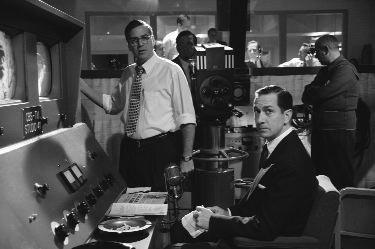Indecent exposure

Whenever Hollywood has tackled the subject of Joseph McCarthy and the work of the House Un-American Activities Committee, the results have tended to be fatuous if not downright embarrassing. George Clooney breaks through the barrier in Good Night, and Good Luck, a compelling portrayal of the last days of McCarthy’s influence.
Clooney, who directed the film and co-wrote the screenplay (with Grant Heslov), gets at McCarthy sideways by focusing on Edward R. Murrow (David Strathairn, perfectly cast), the somber, stentorian commentator and interviewer who embodied CBS News in the 1950s. The movie—whose title comes from Murrow’s famous sign-off phrase—is about the decision by Murrow and producer Fred Friendly (played by Clooney himself) to take a stand against McCarthy’s wobbly, wild-shot accusations and the hysteria and paranoia that his pronouncements fueled.
First Murrow and Friendly take on the case of Milo Ridulovich, who was blackballed by the air force as a security risk on dubious evidence. Then they go for McCarthy himself. Primarily, the journalists are battling McCarthy’s assumption, blindly accepted by many, that those who oppose even the most ill-conceived campaigns against alleged communists must be Reds or communist sympathizers themselves. (That’s exactly the claim McCarthy makes in response to Murrow’s critique.)
Murrow’s on-air excoriating of McCarthy is instrumental in turning the tide against him. But that victory is countered by the simultaneous destruction of newscaster Don Hollenbeck (Ray Wise)—who had flirted with communism in his youth—by Hearst columnist Jack O’Brien. Wise delineates Hollenbeck’s psychic descent with admirable clarity in a few short scenes. His performance provides the high point in a fine ensemble that also includes Frank Langella, Jeff Daniels, Robert Downey Jr. and Patricia Clarkson.
Murrow and Friendly are also pushing against the notion that television, a still-infant medium, is designed to provide mindless entertainment. CBS president Bill Paley (Langella) refuses to censor them, but when Alcoa Corporation pulls its advertising he berates them for subjecting their viewers to a civics lesson. He holds up the counterexample of The $64,000 Question (the hit quiz show that would later generate its own scandal when it was discovered to be rigged): it provides audiences with the entertainment they crave. Paley punishes them by tossing them out of their coveted Tuesday night slot and reducing their reports to a handful of Sunday-afternoon specials.
Clooney and Heslov frame the movie with a 1958 tribute to Murrow, who is shown making an impassioned protest against TV’s pandering to popular taste. Marginally—and less successfully—Good Night, and Good Luck points to the medium’s power to shape audience perceptions. We see the end of an interview Murrow conducts with Liberace that’s deliberately misleading about the performer’s sexuality. An ad for Kent cigarettes links up in our heads with the clouds of cigarette smoke that fill the newsroom at CBS.
Shooting in black and white and using Dianne Reeves’s sultry renditions of pop standards as period markers that also comment subtly on the narrative, Clooney gets the feel of the 1950s exactly right. It’s a beautiful piece of filmmaking. Clooney keeps up a steady buzz of overlapping dialogue, and the actors always seem effortlessly in period and in character. He intercuts the CBS newsroom with actual footage of Murrow’s interviews and of the HUAC hearings (climaxing with the famous clip in which attorney Joseph Welch calls McCarthy on his indecency), and the style of the dramatic scenes is so convincing that the juxtaposition never seems jarring. (It would in any case have been a mistake to cast an actor as McCarthy; in his TV appearances and especially when he attacked Murrow, McCarthy was already a caricature.)
Ultimately, Good Night, and Good Luck provides a model for its own point of view. It’s both unmistakably serious-minded and entirely engrossing. You feel a little smarter when you leave the theater.




